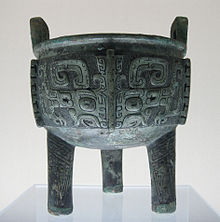ติ่ง (ภาชนะ)
| ติ่ง | |
 ติ่งจากช่วงปลายยุคราชวงศ์ชาง | |
| ภาษาจีน | 鼎 |
|---|---|

ติ่ง (จีน: 鼎; พินอิน: dǐng) เป็นหม้อต้มของจีนยุคก่อนประวัติศาสตร์และยุคโบราณ ตั้งอยู่บนขาตั้งและมีฝาปิดกับหูจับสองข้างที่อยู่ด้านตรงข้ามกัน ติ่งเป็นหนึ่งในวัตถุสำคัญที่ใช้ในกลุ่มเครื่องสัมฤทธิ์ในพิธีกรรมของจีน ติ่งถูกสร้างในสองรูปร่างคือเป็นภาชนะรูปกลมมีสามขากับเป็นภาชนะรูปสี่เหลี่ยมมีสี่ขา รูปร่างแบบที่สองเรียกว่าฟางติ่ง (方鼎) ติ่งใช้ในการประกอบอาหาร ใช้ในการเก็บอาหาร และใช้ในพิธีกรรมบวงสรวงเทพเจ้าหรือบรรพบุรุษ ติ่งที่เก่าแก่ที่สุดที่ค้นพบเป็นติ่งปั้นเผาในยุคก่อนราชวงศ์ชางที่แหล่งโบราณคดีเอ้อหลี่โถว แต่ติ่งที่เป็นที่รู้จักแพร่หลายกว่ามาจากยุคสัมฤทธิ์ โดยเฉพาะหลังราชวงศ์โจวที่ไม่เน้นการบวงสรวงด้วยสุราอย่างที่กระทำโดยกษัตริย์ของราชวงศ์ชาง[1] ในยุคราชวงศ์โจว ติ่งและเอกสิทธิ์ในการประกอบพิธีกรรมที่เกี่ยวข้องกับติ่งกลายเป็นสัญลักษณ์ของอำนาจ[2] จำนวนของติ่งที่อนุญาตให้ครอบครองมีความแตกต่างกันไปตามลำดับขั้นของฐานันดรศักดิ์จีน ติ่งเก้าใบของกษัตริย์ราชวงศ์โจวกลายเป็นสัญลักษณ์ของการปกครองเหนือแผ่นดินจีนทั้งหมด แต่ติ่งทั้งเก้าใบก็สูญหายไปในรัชสมัยของจิ๋นซีฮ่องเต้ผู้เป็นจักรพรรดิจีนองค์แรกเมื่อศตวรรษที่ 3 ก่อนคริสตกาล[3] ภายหลังจากนั้นอำนาจของจักรพรรดิถูกแสดงออกในรูปตราราชลัญจกรซึ่งแกะสลักจากหยกเหอชื่อปี้อันศักดิ์สิทธิ์ ตราราชลัญจกรนี้สูญหายไปในช่วงยุคยุคห้าวงศ์สิบรัฐหลังการล่มสลายของราชวงศ์ถัง
อ้างอิง[แก้]
- ↑ Chen, Jianming; Jay Xu; Fu Juliang (2011). Along the Yangzi River: Regional Culture of the Bronze Age from Hunan. New York: Art Media Resources, Ltd. pp. 23–24. ISBN 978-0-9774054-6-6.
- ↑ Lawton, Thomas (1982). Chinese Art of the Warring States Period: Change and Continuity 480-222 B.C. Washington, D.C.: Smithsonian Institution Press. p. 23. ISBN 978-0-934686-39-6.
- ↑ Food for Thought: Archeological Findings Point to Chinese Dietary Culture เก็บถาวร 2007-02-04 ที่ เวย์แบ็กแมชชีน
บรรณานุกรม[แก้]
- Allan, Sarah (1991). The Shape of the Turtle: Myth, Art, and Cosmos in Early China. Albany: State University of New York Press. ISBN 0-7914-0459-5.
- Delbanco, Dawn Ho. Art from Ritual: Ancient Chinese Bronze Vessels from the Arthur M. Sackler Collections. Cambridge and Washington D.C.: Fogg Museum and Sackler Foundation, 1983.
- Fairbank, Wilma (1962). "Piece-Mold Craftsmanship and Shang Bronze Design". Archives of the Chinese Art Society of America. 16: 8–15. JSTOR 20067039.
- Fong, Wen, บ.ก. (1980). Great Bronze Age of China. New York: Alfred A. Knopf, Metropolitan Museum of Art. ISBN 978-0-87099-226-1.
- Jian ming, Chen; Jay Xu; Fu Juliang (2011). Along the Yangzi River: Regional Culture of the Bronze Age from Hunan. New York: Art Media Resources, Ltd. ISBN 978-0-9774054-6-6.
- Lawton, Thomas (1982). Chinese Art of the Warring States Period: Change and Continuity 480-222 B.C.. Washington, D.C.: Smithsonian Institution Press. ISBN 978-0-934686-50-1.
- Loewe, Michael, and Edward L. Shaughnessy, eds. The Cambridge History of Ancient China: From the Origins of Civilization to 221 B.C. Cambridge: Cambridge University Press, 1999.
- Nickel, Lukas (2006). "Imperfect Symmetry: Re-Thinking Bronze Casting Technology in Ancient China". Artibus Asiae. 66 (1): 5–39. JSTOR 25261842.
- Rawson, Jessica. Chinese Bronzes: Art and Ritual. London: British Museum, 1987.
- Sullivan, Michael. The Arts of China. Berkeley: University of California Press, 2008.
- Wang, Zongshu. Han Civilization. New Haven: Yale University Press, 1982.
- Yang, Xiaoneng, ed. The Golden Age of Chinese Archaeology: Celebrated Discoveries from the People's Republic of China. Washington, D.C.: National Gallery of Art, 1999.
- Xu, Jay (2006). "Shi Wang Ding". Art Institute of Chicago Museum Studies. Notable Acquisitions at The Art Institute of Chicago. 32 (1): 30–31, 95. JSTOR 4104493.
อ่านเพิ่มเติม[แก้]
- Allen, Anthony J. Allen's Authentication of Ancient Chinese Bronzes. Auckland: Allen's Enterprises, 2001.
- Fong, Wen, บ.ก. (1980). The great bronze age of China: an exhibition from the People's Republic of China. New York: The Metropolitan Museum of Art. ISBN 0870992260.
- Lawton, Thomas, ed. New Perspectives on Chu Culture during the Eastern Zhou Period. Washington, D.C.: Sackler Gallery, 1991.
- Lienert, Ursula (1979). Typology of the TING in the Shang Dynasty: A tentative Chronology of the Yin-hsü Period. Germany: Wiesbaden: Steiner. ISBN 3-515-02808-0.
- Rawson, Jessica. Mysteries of Ancient China: New Discoveries from the Early Dynasties. London: British Museum Press, 1996.
- Yang, Xiaoneng, ed. New Perspectives on China's Past: Chinese Archaeology in the Twentieth Century. New Haven: Yale University Press, 2004.
แหล่งข้อมูลอื่น[แก้]
- "Part Two: Bronze Age China: More about Bronze Vessels", National Gallery of Art, Washington, D.C.
- Ding (ritual vessels) in Art & Architecture Thesaurus (Taiwan)
- A Handbook of Chinese Ceramics from The Metropolitan Museum of Art
